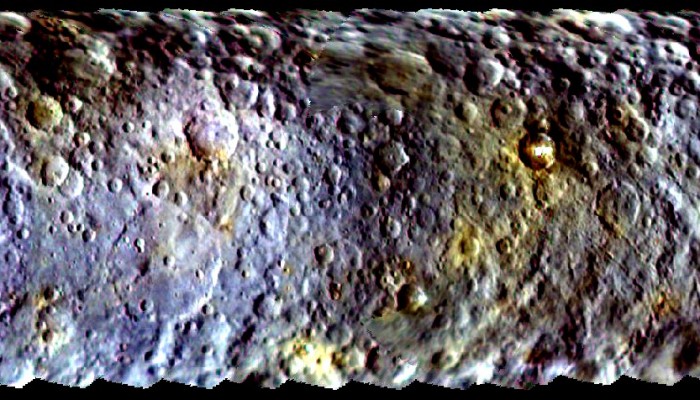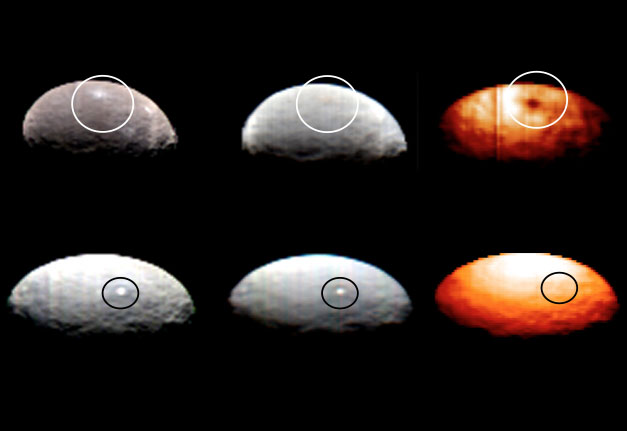
Scientists working on NASA’s Dawn mission revealed new findings from the spacecraft at EGU’s General Assembly. This blog post is brought to you by Nikita Marwaha, reporting on the press conference in Vienna, Austria.
The very first press conference of the 2015 General Assembly this year took a closer look at the surface of Ceres. Scientists working on NASA’s Dawn Mission shared new results from the Dawn spacecraft which has been orbiting the planetary body since 6 March. A new colour map has been released that sheds light onto the planetary body, revealing greater surface diversity than previously thought. Thermal properties of two regions on the dwarf planet are also under question, with scientists spotting vast differences in infrared images taken by Dawn.
Located between Mars and Jupiter, Ceres sits in the asteroid belt and is the second stop on Dawn’s tour of the Solar System – having previously visited smaller asteroid Vesta in 2011 and 2012. The spacecraft captured images during its initial approach to Ceres from which a false colour mosaic map was created. Stark differences in morphology and colour are visible, suggesting that Ceres was once an active body.
“This dwarf planet was not just an inert rock throughout its history. It was active, with processes that resulted in different materials in different regions. We are beginning to capture that diversity in our colour images”, said Chris Russel, principal investigator for the Dawn mission, based at the University of California, Los Angeles.
This enhanced colour view allows scientists to gain an insight into the properties of Ceres’ surface, beyond the range of colours visible to the human eye. Using this technique, physical properties relating to composition, surface texture and morphology can be determined. Complex craters, large curvilinear features and isolated high elevations with steep slopes can also be seen in this map.
The number of craters on Ceres intrigued scientists, having previously studied Vesta which had comparably fewer. Complex craters are an indication of a violent collision history, suggesting that Ceres’ past may be more complex than previously thought. Both Vesta and Ceres are similar in size, yet vary in surface composition. This false colour mosaic map, with its uneven texture, is not as uniform as a body such as Ceres should be, hinting that there is still yet much to learn in the future.
In particular, two spots on the surface of Ceres have caught the Dawn scientist’s attention. First glimpsed up close one month ago, new infrared images unveil that they possess different thermal properties to each other. Named Spot 1 and Spot 5, the two seemed to “behave distinctly differently”, described Federico Tosi at the press conference, who works on Dawn’s Visible and Infrared Mapping Spectrometer (VIR).

These images, taken from Dawn’s visible and infrared mapping spectrometer (VIR,) illustrate two regions on Ceres containing bright spots. The top image is of the region scientists have named Sport 1 and the bottom image is of Spot 5. (Image Credit: NASA/JPL-Caltech/UCLA/ASI/NAF)
Based on observations from NASA’s Hubble Space Telescope, planetary scientists have previously identified 10 bright regions on the surface of Ceres. However, Spot 1 and Spot 5 are the two brightest spots seen on the surface of Ceres.
Upon closer inspection, Spot 1 appears to be cooler than Spot 5. From a thermal perspective, Spot 1 is visualised as a dark spot in the infrared images above, whereas Spot 5 does not stand out in the images. This is because Spot 1 is far cooler than its surroundings, whereas Spot 5 is not and as a result, shows no distinct thermal behaviour. Tosi added that this disappearance of Spot 5 was “the biggest surprise”.
Currently, Dawn is too far away from Ceres to investigate these findings further. More will become clear over the coming months as Dawn emerges from Ceres’ dark side and peers closer to investigate its surface composition and temperature further.
Data gathered from this next period of the mission will provide scientists with images of greater resolution to disentangle the clues that are being collected by the spacecraft. Until then, Ceres’ surface variation and bright spots continue to fascinate the team of Dawn scientists as the mystery surrounding Ceres grows and we learn more about this rocky world.
By Nikita Marwaha, EGU Press Assistant and EJR-Quartz Editor

John
very interesting images, i wonder what the source of the heat is.